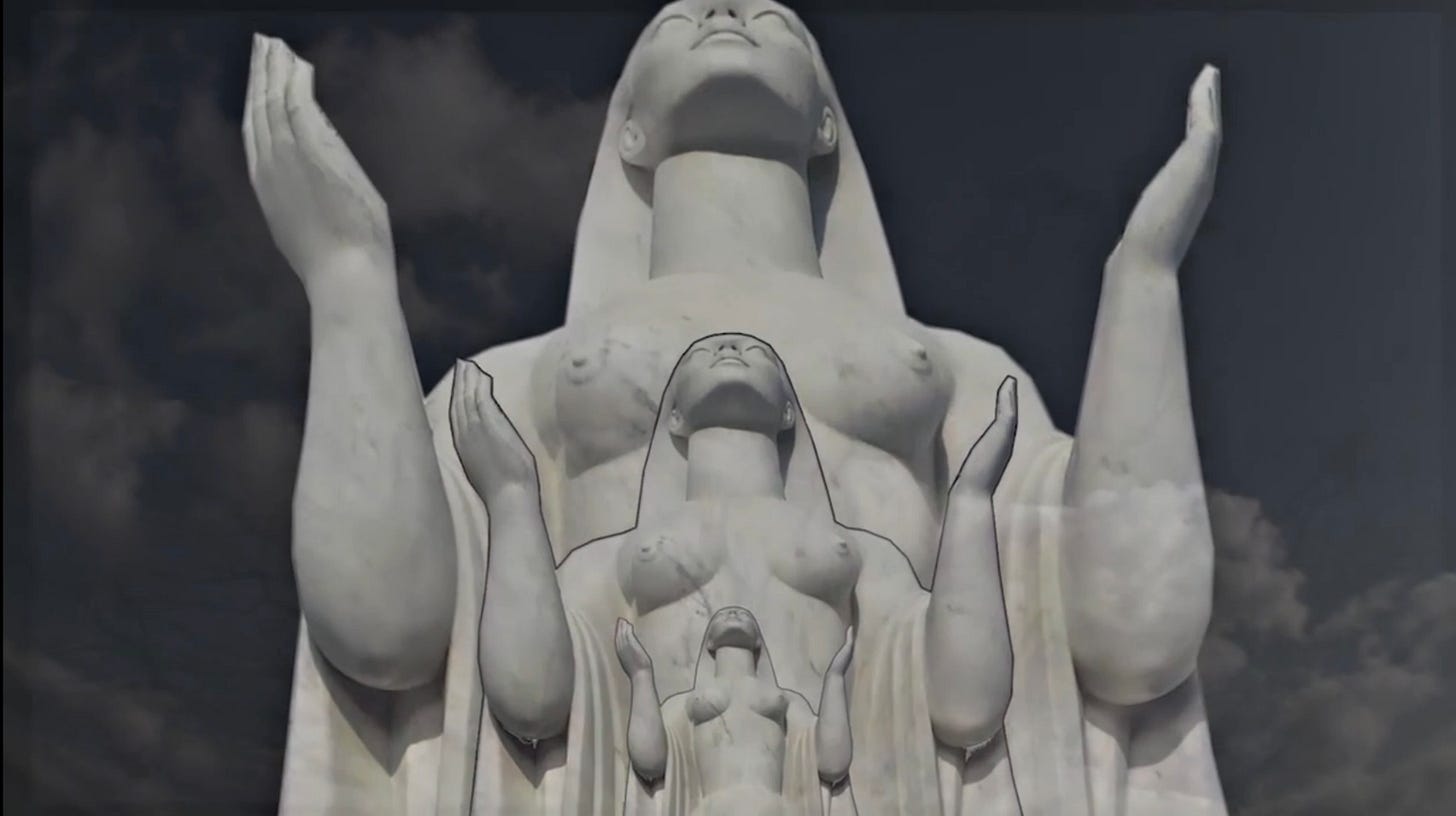Resonating Chambers: Exotic Vector
(2024)
Van McElwee’s 23 minute video Exotic Vector is based on a simple compositional idea: multiple copies of footage expand from the center of the screen, while other images contract in towards the center. These images are composited over one another in intricate ways, making it easier to appreciate the many moving layers. The video is accompanied by the music of gongs and bells. This simple description, however, fails to convey the breathtaking, spellbinding experience of intricately interwoven images which McElwee has bound together, creating a unique cinematic enchantment.
When the images expand, the rate of the expansion slows as it rushes towards us, and when the images contract, they contract faster and faster as they “collapse” into the center. The images explode with the dynamics of fireworks, slowed by air resistance, or rising projectiles, slowed by gravity. The collapsing images, accelerating into the center, share the dynamics of falling objects as well. These dynamics reference the acceleration pattern of gravity, and in combination they give the center of the screen the feeling of a planet, or a black hole, neutron star, or some other massive attractor.
The gongs, musical instruments which send circular sound waves into space, like pebbles dropped in a pond, are sonic equivalents to these rippling waves of imagery, and the complexity of their overlapping sounds mirrors the complexity of what we’re watching.
The video’s opening title announces that we will watch “nested worlds travel to a stationary tourist,” The notion of a “stationary tourist” is a reference to our contemporary experience of “traveling” to distant places while sitting at home, looking at a screen, and the rectangles themselves, as well as frequent images of window frames, doorframes, and other portals, are references to the computer-user’s experience of organizing information into “windows.” Although the viewer will be aware of these computer references, the experience of watching the film is not at all similar to using a computer, and the film is not “about” computers. McElwee uses this overall compositional idea to create his own complex visual meditation, an abstract visual exploration that exploits the dynamic, kinetic properties of moving imagery to give the viewer a thrilling ride through a shimmering, imaginary multiverse.
McElwee includes many symmetrical images, such as palaces and formal gardens, which accentuate the formal symmetry of the structure. These sacred spaces, re-configured into expanding and contracting mandalas, pair well with the sacred associations of the gongs and bells. He also favors video footage of scenes with gentle, minimal movement, such as swaying trees or billowing clouds. Scenes with very complex movement would have distracted us from the interplay of the expanding and contracting frames, whereas this more gentle motion subtly fills the overall visual texture with pulsating life and change.
As is often the case with with McElwee’s films, the formal idea is, in and of itself, an interesting one, but what makes the experience of watching and listening to the film so thrilling and unique is the precision and deftness of his artistic taste and skills. It is the exquisite craft McElwee uses to realize his ideas that makes them so enchanting.
Gradually, the video reveals itself as a structure capable of amplifying resonances, both the sounds and the images. These cascades of multiple, overlapping images evoke the interplay of frequencies, and the different images appear to “excite” new images by picking up “resonances.” The glaciers and waterfalls resonate with the billowing clouds. The clerestory of windows resonate with the branches and leaves of trees. Almost as a response to all of this resonance, certain images begin expanding upwards from the bottom of the frame, principally images of stone idols, their hands and eyes stretching upwards. Like the almost unnoticeable moment when a magic ritual begins to work, these supernatural beings appear unexpectedly, spiraling upwards into the resonating fields, like an answer to a prayer that you don’t realize you are praying. The expanding frames of the imagery bloom like successive moments of consciousness in your brain: each moment being born from the previous one.
Exotic Vector does more than simply make references to spiritual experiences, it employs advanced compositional skills to set up resonating chambers in the viewer’s consciousness, affecting us on a powerful, pre-conscious level, until we feel that our eyes, ears and mind are ringing along with the bells and gongs. In short, it not only speaks about spiritual experiences, it creates the conditions that allow us to have such an experience while watching. This is cinematic art at a high level, indeed.
My articles on experimental film are freely available to all, but are supported by monthly and annual donations from readers. Please consider becoming a paid subscriber to support my work. Thank you.




